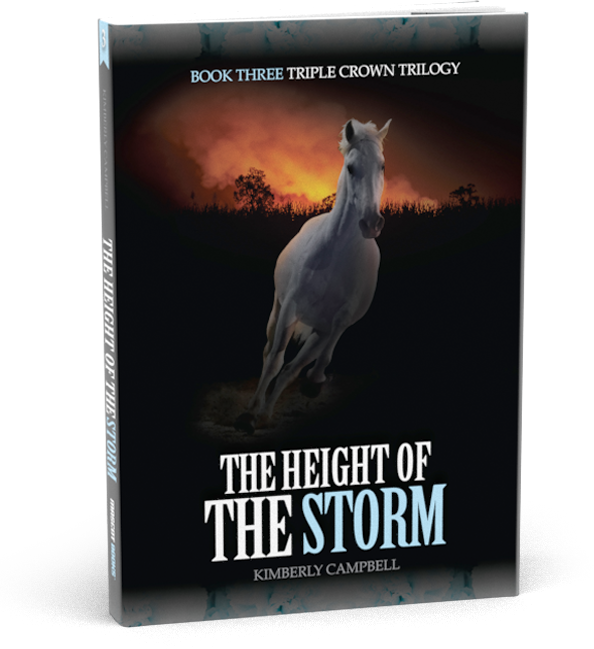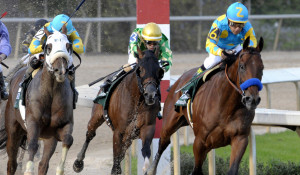THE TRIPLE CROWN TRILOGY by Kimberly Campbell
Breeding Rights, Jockey Athletes and the Sport of Thoroughbred Racing
(Posted on Thursday, May 28, 2015)
Can the sport of horseracing sustain itself, when its most popular figures are retiring after only three months in the spotlight? The Kentucky Derby attracts the interest of the general public, which is heightened when there is a potential Triple Crown winner. After the three Triple Crown races – the Kentucky Derby, Preakness Stakes and Belmont Stakes – we hear of the equine athletes no more. Earlier this month we learned the breeding rights of American Pharoah were sold, and he will retire at the end of this three-year-old season. Including the Belmont, which American Pharoah may or may not win to become the first Triple Crown winner since Affirmed in 1978, his fans will see him run maybe only two or three more times before the end of the year. Then a new star needs to be found to sustain the interest of the public. This scenario is repeated year after year. What if Bryce Harper, in the midst of his home run record setting season, told everyone he was retiring at the end this season, no matter how the Washington Nationals finish, World Series or not? Well, first the fans would flock to the stadiums to watch his last hurrahs, but a rising star would be taken from them in a blink of any eye. Nats’ ownership would need to find the next star to market. As you know, I am a novice in this world of horse racing, and I know there are millions riding on American Pharoah and his ability to procreate. God forbid he gets hurt. But what about the Thoroughbred racing industry as a whole? The stars of the sport retire just as their fan base is growing. I looked at the racing careers of the 11 Triple Crown winners. Here’s is what I found: Sir Barton (1909) – raced as a four-year-old, then retired to stud. Gallant Fox (1930) – stopped racing as a three-year-old due to unexplained fever and cough. Omaha (1935) – raced as a four-year-old, and suffered an injury prior to retirement. War Admiral (1937) – raced as five-year-old, then retired to stud. Whirlaway (1941) – raced as a five-year-old, sustained an injury at the end of his four-year-old campaign. Count Fleet (1943) – after winning the Belmont as a three-year-old, stopped racing due to an injury. Assault (1946) – raced as a seven-year-old. He was to retire as a five-year-old, but was found sterile and returned to racing. Citation (1948) – raced through his six-year-old year, then retired to stud. Secretariat (1973) – retired after three-year-old season, per terms of a syndication deal. Seattle Slew (1977) – raced as a four-year-old, then retired to stud. Affirmed (1978) – raced as a four-year-old, then retired to stud. Of the 11 Triple Crown winners, only Secretariat, was retired due to syndication and breeding rights. His name is the most recognizable of the 11. Imagine his fandom if he had raced as a four-year-old. That being said, the winners of the Triple Crown in the 70’s enjoyed a viewing public during the height of the industry. Since then, Thoroughbred racing’s prominence in the sports world has significantly diminished. (Note: none of the injuries sustained while racing as a four- or five-year-old impacted the horse’s ability to breed later in life. In fact, most went on to have very successful careers as a stallion.) In order to keep the public engaged in the sport of racing, its heroes need to continue racing. If owners are not willing to take on the risks, or are looking to reap monetary rewards prior to their charges fulfilling the public craving for icons to follow, the racing industry should redirect its focus to other heroes in the industry. Heroes who will be around year after year. The jockeys. The jockeys are the men and women who put their lives on the line five or more times a day, 365 days a year, to guide a 1,200 pound animal running more than 35-miles-per-hour with only a hands width separating the competitors. Interestingly, I can name every player on the Washington Nationals baseball team. I could name some big time players on other teams, too. However, I can’t list for you the twenty jockeys who guided the horses in the Kentucky Derby, the biggest horse race of the year. Can you? The majority of the general public knows the name of the horse vying to be the first Triple Crown winner in 37 years. Can they name his jockey? Can you? Maybe it’s time for a bit of change in the industry. Maybe we should recognize and cheer the unheralded athletes – the jockeys. In reality, there would be no horse winning a race if there was no jockey guiding him. KimberlyLeave a Reply
You must be logged in to post a comment.






